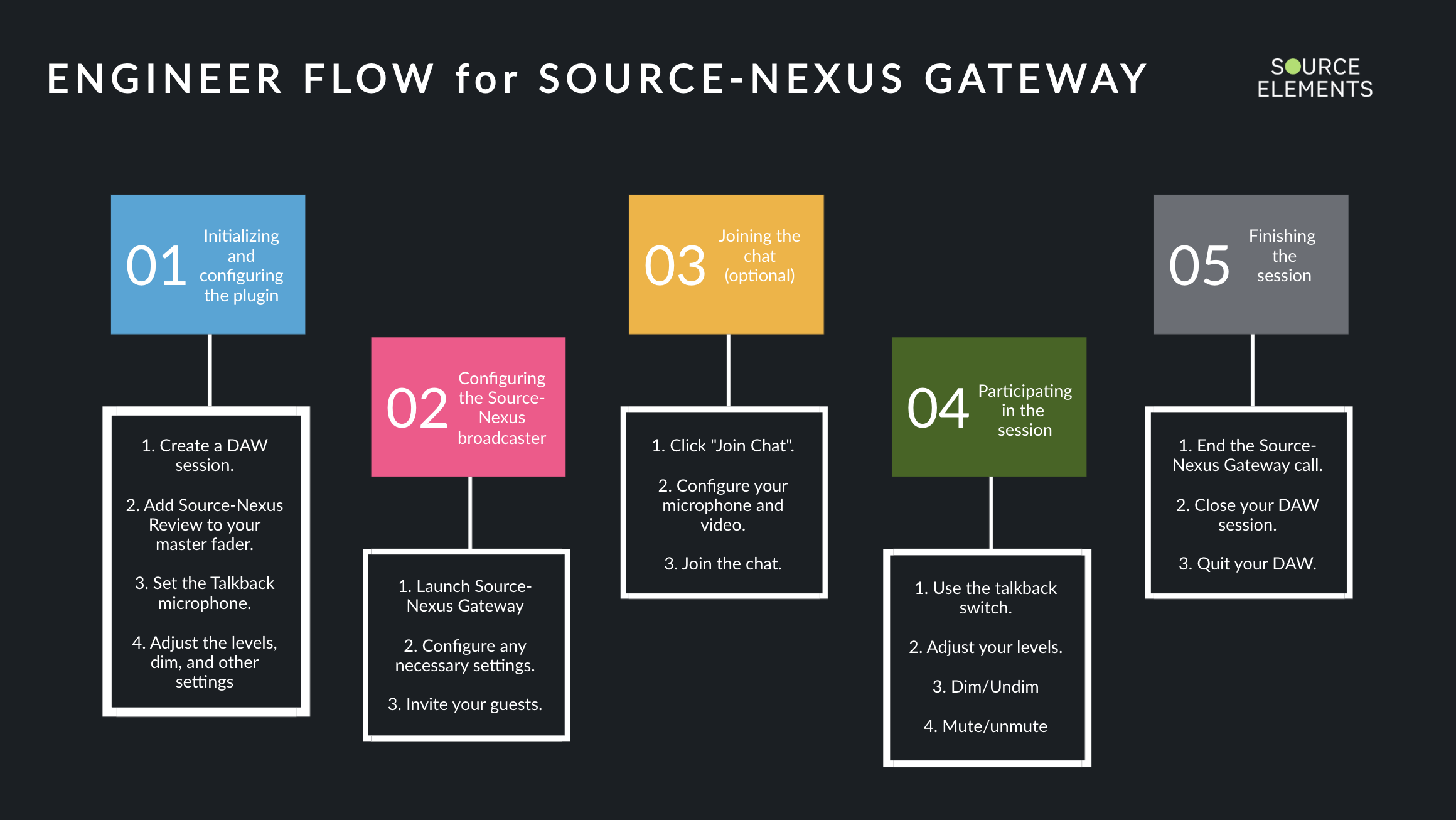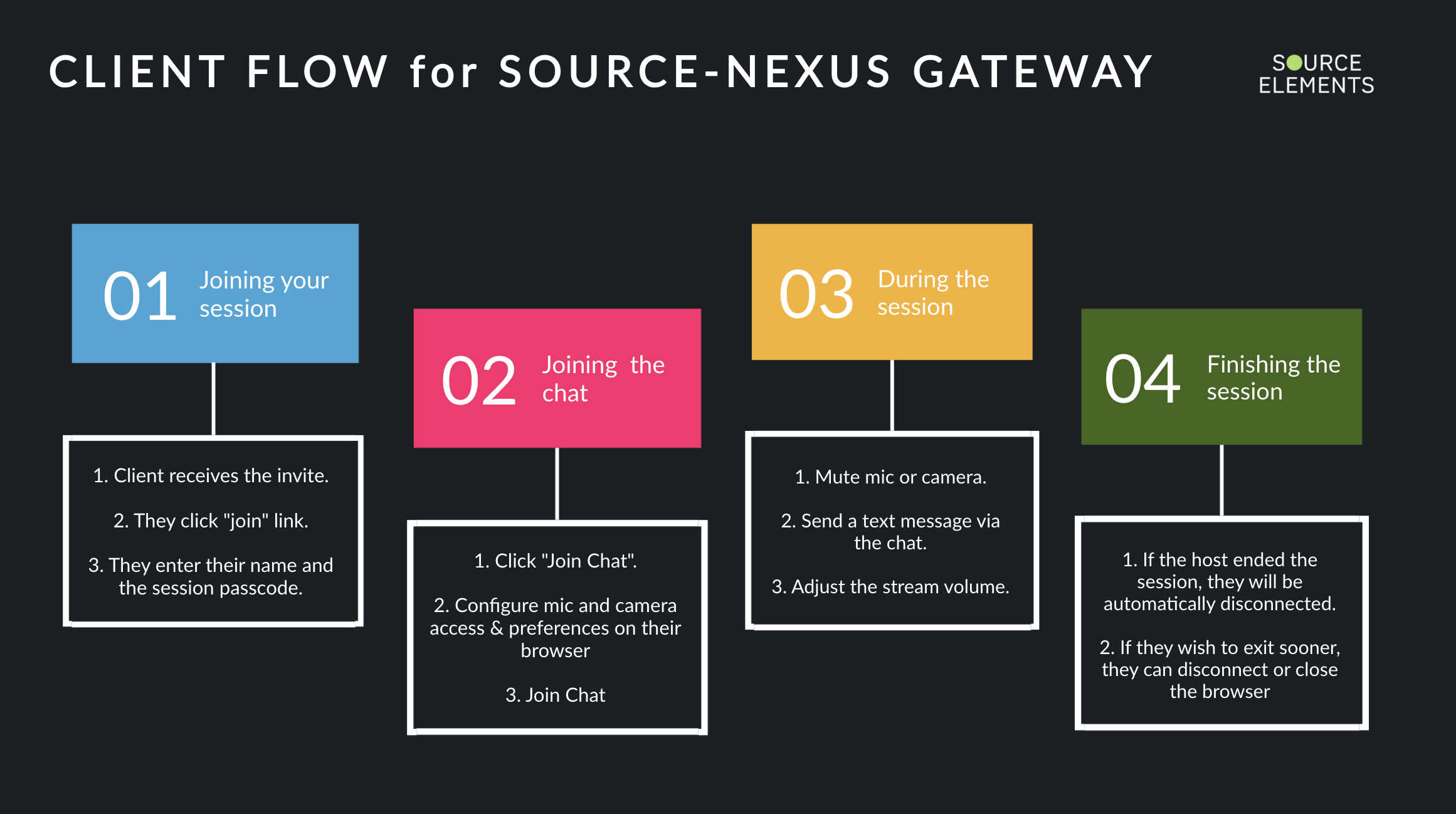Using Source-Nexus Review with the Source-Nexus Gateway broadcaster
This article is part of the Source-Nexus Review and the Source-Nexus Gateway User GuidesWhen doing a mix review, it is always useful to talk to your clients (directors, producers, etc.) to make sure the session is going as expected - they will need to provide feedback and ask for changes, if necessary. Source-Connect, for example, allows you to connect to other users, but it does not offer real-time video features. Source-Live Pro LL does allow you to connect with both audio and video in real-time, but the audio inputs are the same - you cannot separate the mix from your connection partners’ voices.
That is where the Source-Nexus Gateway comes in - it offers you a unique, easy way to invite participants (whether they are your voice-over actors, your team mates, or others) and join you with real-time HD audio and video. Its main benefit is that it has a separate audio input - meaning you can get separate audio streams on both the web and your DAW. If someone connects with you via that tool, the audio will come in separately through the “From Nexus Chat” channel on the Source-Nexus Review plugin.
Working with Source-Nexus Review and Source-Nexus Gateway as an Engineer
When using Source-Nexus Gateway together with the Source-Nexus Review plugin, you will be able to connect with your clients while still adjusting any necessary settings on your DAW. In summary, these will be the steps you will be taking during any mix review session:

Once you have already created your DAW session and adjusted the necessary DAW settings:
- On your DAW, you will instantiate the plugin by dropping it into a stereo master fader track.
- At the top of the plugin, you will choose your Talkback microphone. You will immediately see signal coming into the “To Nexus Chat” channel.
- Once you have your music stereo tracks ready, you will route them into the master fader track. After hitting play, you will see signal going into the “Mix” and the “To Nexus Broadcast” channels.
- If necessary, you can adjust the volume on your channels, dimming anything if necessary, adjusting the volume if you see any clipping indicators or if the sound is too loud.
When you’re comfortable with your DAW session, you can launch the Source-Nexus Gateway by clicking the “SOURCE-NEXUS” button on your plugin. Then:
- Enter your name and passcode, and enable the host login. You will be prompted to enter your password.
- You will have two inputs:
- Microphone - the same as your DAW’s talkback microphone.
- Stream input - the actual mix audio. You can choose “To Nexus Broadcast”. When you hit play on your DAW, it will send the audio from the Source-Nexus Review plugin into the Source-Nexus Gateway.
- If someone is connected, the audio will be coming in separately on the “From Nexus Chat” channel of your plugin. You can test this before having anyone join your session by opening a second browser tab and joining your own session as a second user.
- Only when you’re ready, click “Start broadcasting”.
After your connection partners join you on the call, you can either:
- Use the talkback switch on the plugin to decide when you want to speak or stay silent. By default, the talkback will be latched open.
- Adjust your levels, dim or undim, and mute or unmute any of your channels.
Once the session is over, you can simply end the Source-Nexus Gateway session by closing your browser window or clicking the “Leave Video Chat” button.
Working with Source-Nexus Review and Source-Nexus Gateway as a Client
Users joining you on a session will not need to use a DAW or the Source-Nexus Review plugin. They will just need to connect via the Source-Nexus Gateway. This is how a session would look like for them:

All controls available in the Source-Nexus Gateway on the user-side of the connection are related to the settings they can customize:
- Microphone settings - including a talkback latch and a mute/unmute button.
- Speaker settings - users can configure where the sound is coming out of (including virtual drivers such as the Source-Nexus I/O default drivers or an interface, if needed).
- Camera settings - while useful, it is not necessary for users to have a camera on the web broadcaster. If they choose not to use one, an icon for their initials will be displayed instead.
They can also choose to send an in-call message or share their screens, if necessary.